|
That's a Crock!
by Bob Brooke
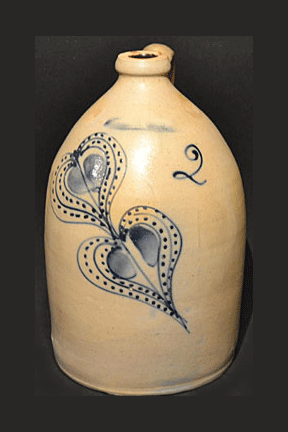 Before
refrigeration, the only way to keep food from spoiling was to store it
in a cool place, usually a cold cellar or spring house. From the early
to mid-19th century, Americans stored various types of food products in
stoneware crocks, the most common piece of kitchen equipment in Colonial
America. Before
refrigeration, the only way to keep food from spoiling was to store it
in a cool place, usually a cold cellar or spring house. From the early
to mid-19th century, Americans stored various types of food products in
stoneware crocks, the most common piece of kitchen equipment in Colonial
America.
American potters made crocks of stoneware, which they covered with an
alkaline or salt glaze and often them decorated using cobalt oxide to
produce bright blue designs. Though people often use the term "crock" to
describe this type of pottery, the word "crock" wasn’t used at the time
these vessels were popular.
Stoneware is a type of pottery that’s fired to about 2192° F. to 2399°
F. While this type of pottery originated in the Rhineland area of
Germany in the 15tth century, it became the dominant piece of kitchen
equipment in the United States between 1780 and 1890. People relied on
stoneware as not only a durable, decorative piece of houseware but as a
safer alternative to lead-glazed earthenware.
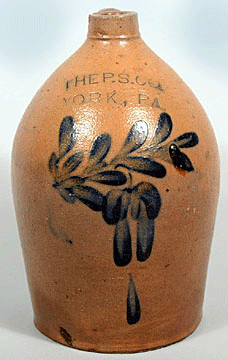 Americans
began producing salt-glazed stoneware in Philadelphia, Pennsylvania, and
Yorktown, Virginia around 1720. By the 1770s, the art of salt-glazed
stoneware production had spread to many locations throughout the
country, most notably Manhattan in New York. By the turn of the 19th
century, the Remmey and Crolius families of potters had set the standard
for expertly crafted and beautiful stoneware. By 1820, potters in nearly
every American city produced stoneware, with those from Baltimore,
Maryland, standing out for their excellent craftsmanship. Americans
began producing salt-glazed stoneware in Philadelphia, Pennsylvania, and
Yorktown, Virginia around 1720. By the 1770s, the art of salt-glazed
stoneware production had spread to many locations throughout the
country, most notably Manhattan in New York. By the turn of the 19th
century, the Remmey and Crolius families of potters had set the standard
for expertly crafted and beautiful stoneware. By 1820, potters in nearly
every American city produced stoneware, with those from Baltimore,
Maryland, standing out for their excellent craftsmanship.
While salt-glazing was the typical glazing technique used by American
potters, many employed other glazing methods. They often dipped vessels
in Albany slip, a mixture made from a clay peculiar to the Upper Hudson
Region of New York, and when fired, produced a dark brown glaze. They
sometimes used this slip as a glaze to coat the inside surface of
salt-glazed ware.
While decorated ware was usually adorned using cobalt oxide, potters
used other decorative techniques. One of them was incising, in which a
potter cut a design of flowering plants, birds, or some other decoration
into the leather-hard clay using a stylus, producing detailed, recessed
images on the vessels. Potters usually highlighted these in cobalt. They
also impressed designs into the leather-hard clay using wooden stamps.
Potters occasionally substituted manganese or iron oxide for cobalt
oxide to produce brown, instead of blue, decorations on their pieces.
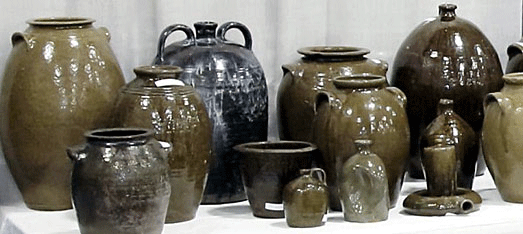
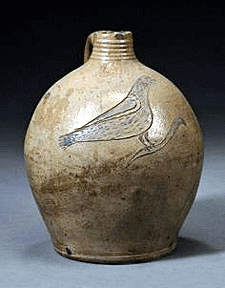 In
the last half of the 19th century, potters in New England and New York
State began producing stoneware with elaborate figural designs such as
deer, dogs, birds, houses, people, historical scenes and other fanciful
motifs including elephants and "bathing beauties." In
the last half of the 19th century, potters in New England and New York
State began producing stoneware with elaborate figural designs such as
deer, dogs, birds, houses, people, historical scenes and other fanciful
motifs including elephants and "bathing beauties."
Most stoneware jugs had some sort of decoration on them which covered
only a small area. Unlike other pottery, they weren’t decorated all
over. Potters commonly painted birds and flowers using cobalt-oxide
glaze or incised them into the surface with a stylus.
More elaborate designs featured chickens standing by a water trough or
sprigs of greenery artfully handpainted with cobalt slip. Sometimes, a
potter would apply his location on the side of the jar or on its base.
A crock’s decoration can often be a clue to where it was made. A
two-gallon jug with a cobalt design of a sailing ship with flag atop the
middle of three fasts, a light-house to the right and a group of rocks
to te left, indicates that it most likely came from New England.
 Potters
signed a good bit of their work using their maker’s mark or sometimes
incised their signatures in the surface of the jar. Many pieces can be
attributed to particular makers based on the cobalt decoration, clay
body, form, and such. They marked the gallon capacity of the vessels
using numeral stamps or incised or cobalt oxide numbers or hash marks
applied freehand. Potters
signed a good bit of their work using their maker’s mark or sometimes
incised their signatures in the surface of the jar. Many pieces can be
attributed to particular makers based on the cobalt decoration, clay
body, form, and such. They marked the gallon capacity of the vessels
using numeral stamps or incised or cobalt oxide numbers or hash marks
applied freehand.
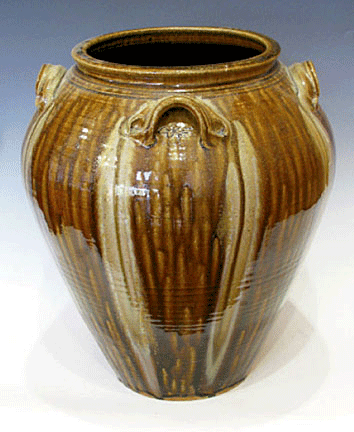 In
recent years, stoneware prices have been climbing higher, especially for
the high-end wares. Most stoneware crocks sell for four to six figures,
depending on their maker and condition. In
recent years, stoneware prices have been climbing higher, especially for
the high-end wares. Most stoneware crocks sell for four to six figures,
depending on their maker and condition.
Collectors continue to pay premium prices for stoneware decorated with
elaborate and unique motifs. Attributed to David Parr Sr. of Baltimore,
a circa-1830 six-gallon jar with a cobalt design of a flower basket that
covered the entire front of the vessel sold for $13,750 at auction. The
back of the jar featured a flowering plant rising' from a mound of
earth. The vessel had rim and base chips, as well as several cracks and
still sold for a high amount.
The same auction contained a one-gallon stoneware jug showing a house,
tree and fence which sold for $10,175. Stamped J. & E.
Norton/Bennington, Vermont, buyers liked this circa-1855 jug not only
for its cobalt decoration, but also for its small size.
Salt-glazed pieces sell for especially high prices. A salt-glazed water
cooler brought $10,500 at auction.
<
Back to More Antique Spotlights
Next
Article >
|
